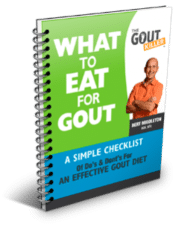It’s that time of year – time for you to figure out what good foods you’re going to grow in your gout garden – and I want to help!
But first, I need to apologize to all of you good gout folks in the southern hemisphere – you’re going to have to save this post for another six months – but right now, it’s time for all of us up here north of the equator to get busy.
Where Does YOUR Food Come From?
That’s the question isn’t it? To come up with an effective diet for gout, it’s not enough to just know “which” foods to eat, it’s really important to know what’s in the soil that’s putting the gout killin’ nutrient density into those foods. If the food you eat most of the time is coming out of a box, bag, can, or a bottle, that’s your first clue about why you’ve got gout. If you can’t grow your food yourself, then you should at least know who did – find yourself a farmers market!

I know a lot of you out there want recipes for gout – all I can say is I’ve got a few, BUT . . . The Gout Wife and I are working on veritable gold mine of them to have for you in the near future. But to be really straight-forward with you, when it comes to cooking and putting food on table, I just sort of wing it. You simply can’t go wrong with a big pile of fresh fruits and vegetables, good olive oil, butter from pasture-fed cows, and maybe a little bit of grass-fed beef or wild-caught salmon!
Growing Your Gout Garden
Let’s review: You’ve got gout. You’re sick of it. You’ve started to drink A LOT more water. And it’s finally sunk in that the TV dinners and the Big Mac, fries, and a coke are more than likely the weapons of your very own massive gout destruction. Congratulations, I applaud you! Now you’re ready to join the living and have a hand at being a small scale farmer, a “micro-farmer” if you will – PERFECT! You and me both! Lets do it the easy way.
It’s usually best to get “starts” from your local nursery – you know, they started the seeds and all you have to do is buy some healthy soil amendments and you’re on your way . . . sort of. First of all, do your best to make sure the starts were done with organic seeds in organic growing material – no weird-ass pesticides, herbicides, or fertilizers allowed. Same goes for the the material you choose to “build your soil” with.
I can’t say enough about this and it ought to be (maybe will have to be) a whole other post – but, just to be clear, that is the start of the downfall of the human race: We’ve trashed the soil and now all the foods that we eat – or all the foods that the animals eat that we eat – are dead and nutrient deficient. I would love to rant on about this but we’ve got work to do, let’s keep moving.
. . .
Hey Bert,
How is everything going? Hope you and Mrs Bert are well and in good spirits.
Well, your email helped me understand what happened. All this time, I thought you must have pulled out your hair suffering with the #Gout, but today you let the secret out: You have just stored so much #gout information up there, trying to help us, that the roots don’t have any where to grow! Bert I do appreciate the unselfish sacrifice you have made…so much so, that the last year i have lived #GOUT FREE! YOU ARE MY HERO! Now let’s lower our head in a moment of silence, for the man that invented computers, for it might have saved your ears!
You know I love ya!
Thanks,
Jimmy
. . .
Easy-To-Grow Foods for Your Gout Garden
As I’ve droned on and on about in the past, eating more alkaline-forming foods than acid forming foods is the starting point for a gout diet. But this is the amazing correlation that has completely fascinated me: Eating more alkaline than acid foods fits in with a low purine diet, The Acid/Alkaline Diet, and the Paleo Diet.
But what is most important right now is to get you growing good foods for gout – here is the Gout Killer gout foods list for easy-growing foods for your garden:
- Red Leaf Lettuce ~ is a clean source of dietary hydration and vitamins like Vitamin K and potassium. Red leaf lettuce likes well-worked soil that is not too wet – plant in rows about six inches apart.
- Kale ~ is a great source of all kinds of vitamins and minerals and a pretty good balance of fatty acids as well as Vitamins A, C, K, folate, magnesium, phosphorus, potassium, calcium, iron and sodium. Kale doesn’t like weather too hot or too cold and is happiest in well-composted growing material.
- Swiss Chard ~ provides some protein and is a fairly good source of phosphorus, magnesium, potassium, calcium, beta-carotene and Vitamin K. Swiss chard is just about the easiest plant to grow; it will grow through the winter, likes cool weather and full sun, and rich composted soil.
- Parsley ~ rich in chlorophyll, Vitamins A, C, K and folate, parsley is a very alkalizing food and a great addition to your gout diet on a consistent basis. Parsley is easily grown and one of the hardiest of plants; it will grow right through the winter. It takes off easily in warm, rich soil.
- Celery ~ the perfect food for gout. Eat it raw. It has lots of water and is very alkalizing because of the all the calcium, potassium, and sodium. Celery is a little tricky to grow – give it ninety days of growing time in warm, rich, moist soil.
- Beets ~ both the bulbous root and the greens are full of vitamins and minerals like sodium, potassium, magnesium, and calcium. Beets are also rich in Vitamins A, C, K, folate and others. Roast the beets with carrots in the oven and saute’ the greens with garlic for full-flavored nutrition. Root vegetables usually don’t come in starts – they grow easily from seed. They grow best when planted in the cool of early spring or a second crop after the heat of summer has pasted and the weather is moving towards the fall. Plant the seeds about 1/2 to 1″ deep in rows about ten inches apart in rich, well-drained, cool soil.
- Carrots ~ rich in minerals like potassium, magnesium, Vitamin A and choline, carrots are a great, portable, and hydrating food for gout snacks. Another root vegetable, sow the carrot seeds in early spring and harvest all through the growing season at different times. Carrots even do well into the late fall and early winter. Plants and grow much like you do beets.
- Yellow Squash ~ should be harvested when small and the seeds inside have not had a chance to develop. Yellow squash can be grated and prepared raw and mixed with olive oil and apple cider vinegar, or sauteed with lots of good butter and then salt and peppered. Yellow squash has a nice balance of minerals and vitamins and is especially delicious when picked fresh and eaten right away. Squashes need quite bit of space as they can grow to be huge but make you look like a hero of a gardener when they do. A very easy plant to grow, squash likes rich moist soil and should be planted after the danger of frost has pasted.
- Chives ~ are fairly minimal in vitamin and mineral nutrients but huge on flavor. A form of onion, chives can spice up any salad, saute’, or happy hour snacks making taste sensations simple. Grow from starts and transplant in a sunny spot in healthy rich soil.
Getting in touch with your food by growing it yourself is a fundamental step toward freeing yourself from gout – after all, you are what you eat so keep that every time you sit down at the table.
☆ Remember! The best foods for gout come straight out of your garden!
References
- SELFNutritionData
https://nutritiondata.self.com/ - The American Gardener
https://ahsgardening.org/

“I know your pain. Let me help you kill your gout for good! And teach you to advocate for yourself and take ownership of your gout recovery, by showing you how to live the gout-free lifestyle.” Two decades ago, Bert Middleton found himself diagnosed with gout. Like 8.3 million other people in the United States (approximately 4% of the population), he struggled helplessly with the physical, emotional, social, and financial impact that gout left unchecked can have on your life. Prescription drugs were of limited help… And the terrible pain of regular gout attacks left him unable to enjoy even the simplest daily pleasures. His marriage was suffering. His finances were spiraling due to the impact gout had on his ability to work. And maintaining a social life was often nearly impossible. Tophi surgeries left him in terrible pain. And he found himself depressed … and angry … that gout was stealing years of his life.
Until one day, after hundreds of hours of research and self-experimentation, Bert finally had a breakthrough and created a blueprint for a way of living that would prove to be “the answer” to living gout-free for nearly a decade now. Today, Bert and his “Gout Wife” Sharon devote their evenings and weekends to educating other gout sufferers on how to live the gout-free lifestyle. Showing others his 911 Emergency Response Gout Recovery Plan for getting PAINFUL gout attacks under control in as little as 4 hours. And then, how to make daily choices that keep gout under control for GOOD! So you can finally start LIVING again!

